Active Monitoring Berlin
During construction works for Berlin’s new mobility concept, a special problem connected to the Perleberger Bridge located in the quarter Tiergarten occurred. Situated to the north of Lehrter Train Station, Berlin’s most important hub for rail transportation in the future, the bridge construction, an important road connection between the quarters Moabit and Wedding, had to be replaced.
The Perleberger Bridge spans a ditch with several railway tracks that are used all day long by locomotives to operate the train station’s shunting service. And another problem caused difficulties for the reconstruction: the railway company Deutsche Bahn AG was building an elevated railway track crossing above the new bridge, a so-called ‘Fly-Over’, at the same time the reconstruction was going on. Due to the fact that it was impossible to close all roads and rails for traffic under and on top of the bridge, it was decided to keep one side of the old bridge in place so that road traffic was allowed to continue. New foundations had to be put in place right next to the pillar foundations on both sides of the old bridge, so that building measures for the new bridge section and the elevated railway track could commence. The civil engineers had been made aware of damages that occurred during those foundation works for the new ‘Fly-Over’ in the area of the northern abutment. The ground settlements were up to 6 cm deep and thus also posed a threat to one of the old bridge pillars. In that area vertical settlements with a depth of 15 mm were already regarded as a critical limit that would have made it necessary to close all traffic routes under and on top of the bridge. It had become clear that it was essential to permanently and actively monitor the pillar in question. Therefore a measuring system was required which was able to detect vertical movements at short intervals and at the same time allow for the two extensive construction measures to continue despite of the busy shunting service on the rail tracks.
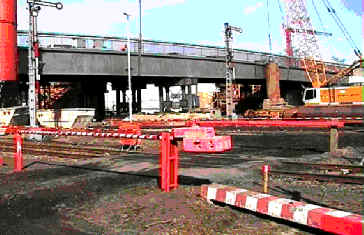
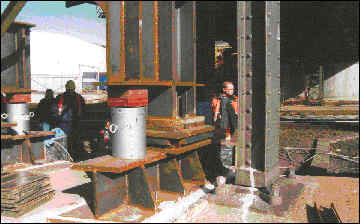
As soon as predefined limits were exceeded or certain events occurred, the system had to send a message or an alarm signal, depending on the type of event that had occurred and its priority. In order to receive those messages, a 24 hour on-duty service was set up so that continuous monitoring could be realized and, if necessary in the worst case, all traffic routes could be closed under and on top of the bridge.
Berlin’s Senate Department for Urban Development, responsible for public civil engineering structures, was named as the competent authority in that case. In case a certain limit value was exceeded, the local construction site management as well as a steel construction company had to be informed. This was necessary to make sure that the bridge could be brought back into position using the installed hydraulic presses and a structure that helped to keep the bridge in place. A flashing light was installed on the construction site in close proximity to the danger area so that workers could be made aware of a possible threat visually.
Due to the conditions present at the construction site, some more or less smaller issues posed a problem for the question which measuring system to use. For instance, the use of optical instruments requires good and clear visibility, and the installation sites for such instruments need to be close to the measurement object and unaffected by external influences. That, however, was not the case on the construction site.
Likewise, the difficult physical conditions on site, for example light refraction and diffraction, further diminished the accuracy that could have been achieved by using those geodetic instruments. One requirement to be met by the measuring system was to allow for fast data analysis in order to draw reliable conclusions regarding any changes at the measurement object.
Measurement Task
The main task was to monitor changes in height at pillar foundations of the Perleberger Bridge during ongoing construction works. To that end, FPM Holding GmbH was ordered to install the Automatic Hydrostatic Leveling System ASW 2000 in order to carry out the monitoring service. For that purpose the system was only rented to the contracting authorities during the measurement period. The equipment consisted of 6 measuring units including PC, interface, laptop and software. The system had to perform the following tasks in the course of the entire project:
- carry out continuous monitoring measurements on the construction site
- detect relative changes in height at selected measurement points
- perform synchronous measurements at all reference points
- meet the accuracy requirement of ± 0.05 mm or better
- software-controlled automatic measurements with adjustable measuring intervals
- allow for correct functioning in a temperature range between -20°C … +55°C
- allow for correct functioning during ongoing shunting service in close proximity
- data recording and storage on a PC
- graphical data representation on a screen
- allow for access to a table with the measurement data using a laptop
- allow for remote servicing using a laptop and PcAnywhere
- send automatic alarm messages as soon as a predefined value has been exceeded
Equipment Setup
Based on the requirements regarding accuracy, availability and measuring range, the hydrostatic leveling system ASW 2000 offered an adequate solution for all tasks that had to be carried out. Thanks to a PC interface it was possible to control variable number of measurement units and analyze the recorded data. Six measurement devices were installed in total. Four of them were positioned at the concrete base plate of the bridge pillar at risk, and two units were placed as firmly installed reference points at a distance of approximately 80 meters on a safe and movement-free base plate that was part of a railway control center. The PC was set up in an office container 300 m away from the bridge foundation. The measurement data was stored on the PC in ASCII format. The measurement cycles were set to 3 minute intervals, and the system was able to detect vertical displacements in a range of 60 mm with an accuracy of ± 0.01mm.
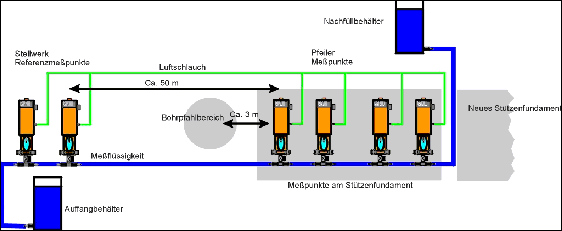
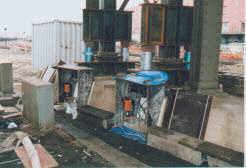
Measurement device at the bridge pillar

Fixed reference point
In order to verify that the pillar foundation had been displaced, the values measured by the four devices at the base plate were compared to one of the two firmly installed reference points. If the first reference point could not be used due to a technical problem, the software automatically switched to the second reference point immediately. Thus a technical defect did not result in a failure of the entire measuring system. After determining the extent of vertical movements at the bridge pillar caused by traffic load and temperature changes, the limit values for sending messages were defined and entered into a monitoring program. Any changes to the control and monitoring program required a password entry and were registered. According to adjustable time periods, the program compared the changes in height of the individual measurement devices to the predefined limit value.
If one of the measurement units had detected a vertical displacement of ± 10 mm, the system would have automatically sent an alarm message to the corresponding on-duty service staff. At the same time all construction works close to the bridge would have had to be interrupted and a flashing light would have signaled to all personnel that the site had to be evacuated. In order to avoid such an event, the on-duty service staff were able to access all relevant measuring data via laptop (either analog or ISDN connection) and, if necessary, arrange for measures to lift the bridge using the hydraulic system.
The senate’s on-duty service staff was kept informed on the operating status of the automatic hydraulic measuring system, because that was important for their ability to carry out service and maintenance works if necessary. For that reason, the system also generated automatic messages in case one of the measuring devices was about to possibly fail. In addition, an operating signal was sent out automatically every 30 minutes to a security company that was supposed to activate certain alarm mechanisms in case the signal did not appear on time. All signals and messages were also transmitted to FPM Holding GmbH and recorded.
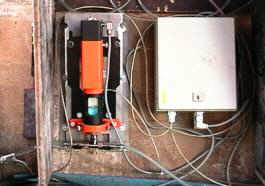
Single measurement device
at the bridge pillar
The measuring results obtained by using that active monitoring system confirmed that the enormous efforts with regard to technical equipment and logistics had been justified. In the course of the 12 week monitoring period there had been several incidents that made it necessary to activate the on-duty service staff, but only to make sure that the system operated correctly.
The maximum ground settlement detected at the pillar foundation was 2.3 mm and thus not critical with regard to the ongoing traffic. Thanks to the Automatic Hydrostatic Leveling System ASW 2000 and all its electronic measuring components, data transmission and intelligent communication solutions, all building activities in the vicinity of the Perleberger Bridge construction site had been monitored safely.
Literature:
Tresp, T.: Bauwerksüberwachung in Berlin: Messtechnische Konzepte zur Kontrolle von Verkehrs- und Ingenieurbauten; Zeitschrift: „Der Vermessungsingenieur“ - Heft: 5 / 2000 (Tresp, T.: Building Monitoring in Berlin: Measurement Technologies for Monitoring Traffic and Engineering Constructions; Magazine: „The Surveying Engineer“ – Edition: 5 / 2000)


